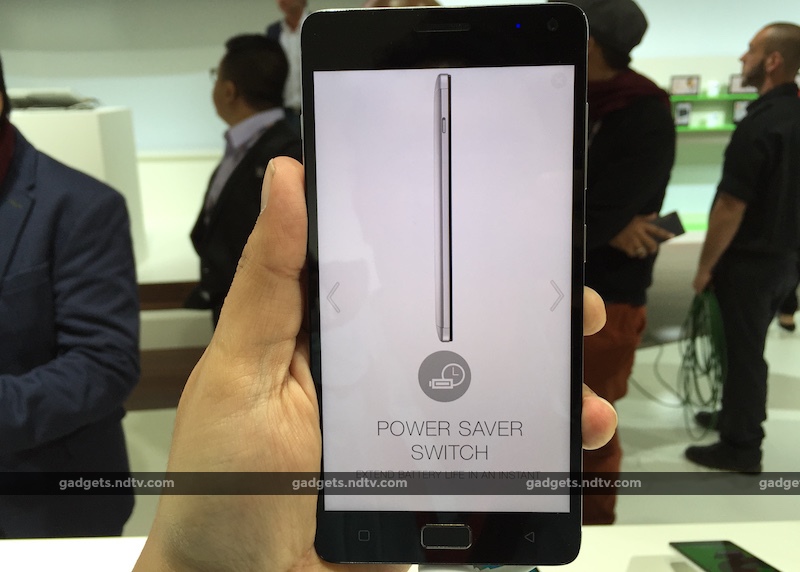- Home
- Mobiles
- Mobiles Reviews
- Lenovo Vibe P1 and Vibe P1m First Impressions
Lenovo Vibe P1 and Vibe P1m First Impressions

Back to what you came here to read - how the two smartphones perform. This power saving mode isn't too dissimilar to what you've seen on other smartphones - it basically takes away your standard launcher and leaves you with a handful of apps you can use while in this mode - the Phone (dialler), Contacts, SMS, and Clock are the usual suspects. Lenovo's implementation leaves mobile data on - we couldn't verify if it disables 3G/ 4G in a bid to save power - and also a chat app. The unit we saw had QQ available, and we were told the international variant will let you pick WhatsApp instead.
(Also see: Lenovo Vibe S1, Vibe P1, and Vibe P1m Smartphones Launched at IFA 2015)
Lenovo's power saving mode launcher has room for six apps on the 'home screen' and you have some amount of control over which apps should be shown. Lenovo lets you pick from a pre-approved list of apps that you can use in this low power state. The unit we saw had only two options available other than the five apps we mentioned above. What apps need to do to make the power saving mode cut isn't available, though it's clear your browser will never be on that list.
In terms of the rest of the specifications, the Lenovo Vibe P1 is a dual-SIM (dual LTE) smartphone that comes with a 5.5-inch full-HD display with Corning Gorilla Glass 3 protection. It is powered by a Snapdragon 615 octa-core processor alongside 2GB of RAM and 16GB of expandable storage. the Lenovo Vibe P1 has a 13-megapixel rear and 5-megapixel front shooter. The P1m is more modest, with a 5-inch 720p display, 2GB RAM, and 8-megapixel rear camera.
(Also see: Lenovo Vibe P1 and Vibe P1m full specifications)
Get your daily dose of tech news, reviews, and insights, in under 80 characters on Gadgets 360 Turbo. Connect with fellow tech lovers on our Forum. Follow us on X, Facebook, WhatsApp, Threads and Google News for instant updates. Catch all the action on our YouTube channel.
Related Stories
- Samsung Galaxy Unpacked 2025
- ChatGPT
- Redmi Note 14 Pro+
- iPhone 16
- Apple Vision Pro
- Oneplus 12
- OnePlus Nord CE 3 Lite 5G
- iPhone 13
- Xiaomi 14 Pro
- Oppo Find N3
- Tecno Spark Go (2023)
- Realme V30
- Best Phones Under 25000
- Samsung Galaxy S24 Series
- Cryptocurrency
- iQoo 12
- Samsung Galaxy S24 Ultra
- Giottus
- Samsung Galaxy Z Flip 5
- Apple 'Scary Fast'
- Housefull 5
- GoPro Hero 12 Black Review
- Invincible Season 2
- JioGlass
- HD Ready TV
- Laptop Under 50000
- Smartwatch Under 10000
- Latest Mobile Phones
- Compare Phones
- Honor Win RT
- Honor Win
- Xiaomi 17 Ultra Leica Edition
- Xiaomi 17 Ultra
- Huawei Nova 15
- Huawei Nova 15 Pro
- Huawei Nova 15 Ultra
- OnePlus 15R
- Asus ProArt P16
- MacBook Pro 14-inch (M5, 2025)
- OPPO Pad Air 5
- Huawei MatePad 11.5 (2026)
- Xiaomi Watch 5
- Huawei Watch 10th Anniversary Edition
- Acerpure Nitro Z Series 100-inch QLED TV
- Samsung 43 Inch LED Ultra HD (4K) Smart TV (UA43UE81AFULXL)
- Asus ROG Ally
- Nintendo Switch Lite
- Haier 1.6 Ton 5 Star Inverter Split AC (HSU19G-MZAID5BN-INV)
- Haier 1.6 Ton 5 Star Inverter Split AC (HSU19G-MZAIM5BN-INV)



















